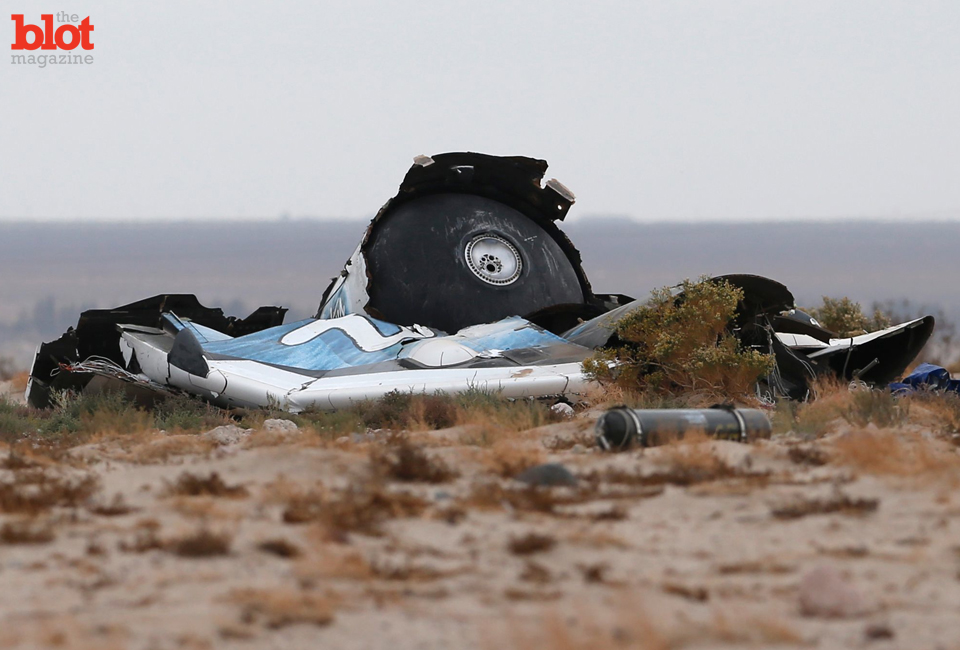Like everyone else who grew up with the space program, I was saddened greatly by Friday’s crash of Virgin Galactic’s SpaceShipTwo in the Mojave Desert. Michael Alsbury, who died in the crash, is as much a hero as any one who lost his life in the field of space exploration. He’s there with the guys who died in the Apollo fire, the Challenger and Columbia accidents and the four Soviets who died in the Soyuz program. That he died a hero’s death, however, does nothing to change the fact that, under current technology, there is no purpose at all to manned space flight.
All one has to do is look at the International Space Station to see this is so. What exactly are they doing up there? The truth is that, as a scientific endeavor, the ISS is a waste of resources. There are no experiments done up there that could not be done just as well in an unmanned lab. The exception to this is the effect that being in space has on human beings, which is a circular argument. Moreover, after the space endurance records from the Mir station, there isn’t much new to be uncovered there either. As one space scientist, Nicolaas Bloembergen (yes, two As) of Harvard, told Congress once, “microgravity is of microimportance.”
As for sending a human being to the moon, an asteroid or Mars, the same thing applies. We’ve been to the moon, half a dozen times. We’ve brought back the rocks, set up the sensors, and yes, we’ve walked on another world. What point is there to walking on it again? A permanent moon base for scientific research looked great in “2001: A Space Odyssey,” but no one backing the idea has yet established a research program that requires human beings to participate. Asteroids offer even less for humans to do.
That leaves us Mars, and I will admit that the idea of landing on Mars makes my blood run a little quicker. Yet again, after we get there, what do we do that can’t be done by the robots that we have already sent up there?
And so I am left wondering just what Virgin Galactic and the other private space companies plan to do other than give rich people a new thrill (which isn’t a bad idea commercially, but doesn’t do a thing to advance civilization either). Virgin Galactic’s business plan is to fly its craft on a suborbital flight and take passengers to the edge of space. Alan Shepard and Gus Grissom did that back in 1961; this accomplishment is as old as I am (actually, I am a few months younger). At best, space tourism will be an expensive version of the current cruise-ship industry — no purpose but being there.
Looking at Mars again, since 1960, there have been 43 missions to Mars by various nations. Of these, 25 have been partial or complete failures. The success rate has improved over the years; the last 10 missions have succeeded eight or nine times depending on how you measure it. But as late as the 1990s, six out of eight failed. Now, consider that kind of failure rate and a manned mission. Not exactly appealing.
The biggest problem with manned spaceflight is keeping the spacefarers alive. They need food, water, a breathable atmosphere, and all of this increases the weight of the payload. That increases the amount of fuel required to achieve orbit, and that means you have a bigger potential problem. Bringing them back home is also problematic. Challenger, Columbia and three of the Soviet deaths were tied to re-entry issues. Mars One, a private company planning to take people to Mars, has a solution — a one-way trip.
There is, I admit, a dimension to the human spirit that simply wants to explore, to see what’s beyond the next bend in the river. For that reason, there will always be a heartfelt appeal to human space exploration.
But let’s use our heads here. Voyager 1 and 2 were launched in the 1970s and traveled the solar system. They are still moving away from the sun and sending back data. The Jet Propulsion Laboratory says, “In August 2012, Voyager 1 made the historic entry into interstellar space, the region between stars, filled with material ejected by the death of nearby stars millions of years ago. Scientists hope to learn more about this region when Voyager 2, in the ‘heliosheath’ — the outermost layer of the heliosphere where the solar wind is slowed by the pressure of interstellar medium — also reaches interstellar space. Both spacecraft are still sending scientific information about their surroundings through the Deep Space Network, or DSN.”
Meanwhile, the guys who travel just 205 miles up to the ISS aren’t doing much of anything. The latest blog post from NASA notes that the agency “has been conducting rodent research in space for many years. The majority of those investigations focus on clinical questions about how we keep our astronauts healthy in space for longer periods. They also address very basic life science questions about how animal physiology changes in a weightless environment.” In other words, we’re going up there to see what happens when we go up there.
Three days before the Virgin Galactic crash, Orbital Sciences tried to launch a cargo vessel to the ISS, and it exploded in the first few seconds of flight. The loss was around $200 million. But no one died. It’s not really much of a choice — risking human life to achieve next to nothing, or risking space probes to discover the secrets of deep space.
Maybe when we figure out warp drive …
Jeff Myhre is a contributing journalist for TheBlot Magazine.







One Comment
Leave a Reply